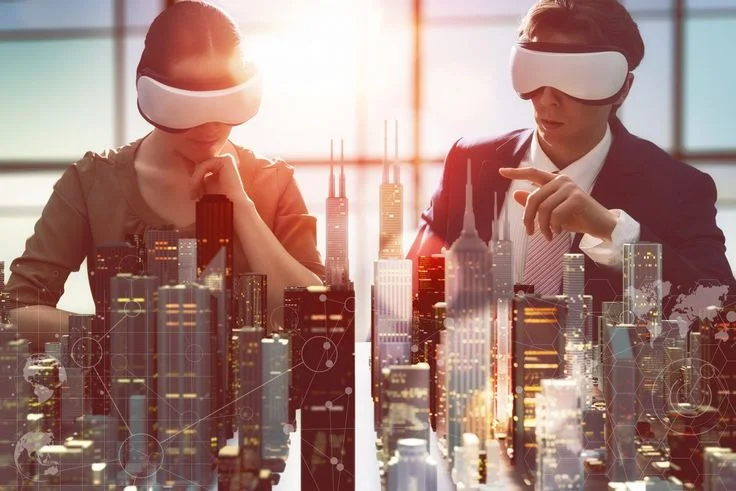Welcome to the incredible world of Virtual Reality (VR), where your imagination comes alive, and the boundaries of reality blur! In this comprehensive post titled “Virtual Reality: A Deep Dive into Immersive Technology and Its Applications”, we invite you on a fantastic voyage. From VR’s genesis to its current applications across myriad industries it’s all here! We will journey through immersive gaming experiences, explore how doctors are using VR for complex surgeries, and even delve into its potential role in space exploration.
This technology is rapidly evolving beyond the realm of entertainment – transforming education, healthcare, real estate & more with breathtaking possibilities. Whether you’re tech-savvy or just curious about what makes this disruptive technology tick something is fascinating for everyone as we go deep beneath the surface of virtual reality. Are you ready to dive in ? Don’t just observe from afar; let us guide you towards fully understanding and possibly shaping the future with VR.
Understanding the Concept of Virtual Reality
Virtual reality (VR) is a cutting-edge technology that immerses users in digital environments. By wearing a VR headset, users enter a simulated reality that can be interacted with and explored in real time. This immersive experience is achieved through a combination of advanced hardware and software, including motion tracking sensors, high-resolution displays, and realistic audio. The goal of virtual reality is to transport users to a fully immersive, computer-generated world where they can experience sights, sounds, and even physical sensations as if they were truly present. This technology has applications across various industries, from entertainment and gaming to education and healthcare, offering unique and engaging experiences that were previously unimaginable.
Evolution and Development of VR Technology
Virtual reality (VR) technology has undergone significant evolution and development since its inception. Initially conceived for military and aviation training purposes, VR has now become a versatile tool with applications across various industries. The evolution of VR can be traced back to the 1960s, with early developments focusing on creating immersive simulated environments through basic head-mounted displays. As technology advanced, VR systems became more sophisticated, incorporating motion tracking, haptic feedback, and realistic graphics to enhance the user experience. Today, VR technology has expanded beyond gaming and entertainment to revolutionize fields such as healthcare, education, and architecture. With ongoing advancements in hardware and software, the future of VR technology holds even greater promise for immersive and interactive experiences.
Various Types of Virtual Reality Systems
Virtual Reality (VR) technology encompasses a diverse range of systems that offer immersive experiences in different ways. One type of VR system is fully immersive VR, which typically involves the use of a head-mounted display (HMD) that covers the user’s entire field of view. This type of system transports the user to a completely virtual environment, providing a highly realistic and engaging experience.
Another type of VR system is augmented reality (AR), which overlays digital information or virtual objects into the real world. AR systems often use transparent displays or smartphone cameras to blend the physical and virtual worlds seamlessly. This technology has applications in fields such as gaming, navigation, and education.
Mixed reality (MR) is a hybrid of virtual and augmented reality that allows users to interact with both digital and physical elements simultaneously. MR systems enable users to manipulate virtual objects in real time within their physical environment, creating a unique and interactive experience. Beyond these main types, there are also simulations and 360-degree videos that offer varying levels of immersion. Simulations replicate real-world environments or scenarios. Undoubtedly allowing users to practice skills or explore places that may be difficult to access otherwise. 360-degree videos capture a panoramic view of a location or event, enabling viewers to immerse themselves in the scene as if they were physically present.
Immersive Experiences: The Power of VR in Different Industries
Virtual reality (VR) technology offers a wide range of immersive experiences that have the power to revolutionize various industries. In the realm of entertainment, VR allows users to enter virtual worlds and experience scenarios that would be impossible in the real world. From interactive gaming experiences to immersive storytelling in movies and television, VR is reshaping the way we consume entertainment. In the field of education, VR provides a unique opportunity for students to engage with complex concepts in a hands-on and interactive way. For example, medical students can practice surgical procedures in a virtual environment. Thereby allowing them to gain valuable experience before working with real patients.
Similarly, history students can virtually visit historical sites and events, bringing their learning to life in a way that traditional textbooks cannot match. The potential of VR extends beyond entertainment and education, reaching into industries such as healthcare, architecture, and tourism. In healthcare, VR is being used for therapeutic purposes, such as treating patients with phobias or PTSD. Architects can use VR to design and visualize buildings before they are constructed, while the tourism industry can offer virtual tours of destinations around the world. Overall, the power of VR lies in its ability to transport users to new and exciting worlds. This provides experiences that are both immersive and interactive. As technology continues to advance, the possibilities for its application across various industries are limitless. Thereby, promising a future where virtual reality plays an increasingly important role in our everyday lives.
Future Predictions for Virtual Reality Applications
As virtual reality technology continues to rapidly evolve, the future holds exciting possibilities for its applications. One prediction is the widespread integration of VR in education. This allows students to immerse themselves in historical events or scientific concepts. Another trend is the growth of VR in healthcare, with simulations aiding in surgical training and therapy sessions. Furthermore, virtual reality is expected to revolutionize the way we shop. This is through virtual fitting rooms and immersive product experiences becoming the norm. As technology becomes more accessible and affordable, we can anticipate a proliferation of VR applications across various industries. This is transforming the way we work, learn, and entertain ourselves.

 Exploring the Latest Social Media Trends and How to Use Them
Exploring the Latest Social Media Trends and How to Use Them 10 Hidden iPhone Features You Didn’t Know Existed
10 Hidden iPhone Features You Didn’t Know Existed